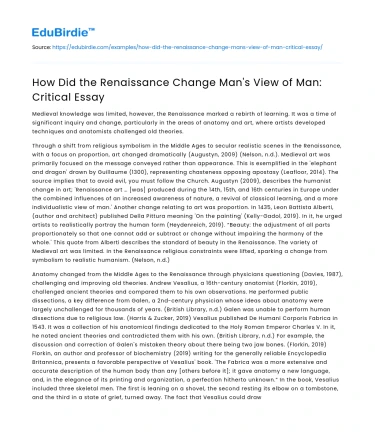Medieval knowledge was limited, however, the Renaissance marked a rebirth of learning. It was a time of significant inquiry and change, particularly in the areas of anatomy and art, where artists developed techniques and anatomists challenged old theories.
Through a shift from religious symbolism in the Middle Ages to secular realistic scenes in the Renaissance, with a focus on proportion, art changed dramatically (Augustyn, 2009) (Nelson, n.d.). Medieval art was primarily focused on the message conveyed rather than appearance. This is exemplified in the 'elephant and dragon' drawn by Guillaume (1300), representing chasteness opposing apostasy (Leafloor, 2014). The source implies that to avoid evil, you must follow the Church. Augustyn (2009), describes the humanist change in art; 'Renaissance art … [was] produced during the 14th, 15th, and 16th centuries in Europe under the combined influences of an increased awareness of nature, a revival of classical learning, and a more individualistic view of man.' Another change relating to art was proportion. In 1435, Leon Battista Alberti, (author and architect) published Della Pittura meaning 'On the painting' (Kelly-Gadol, 2019). In it, he urged artists to realistically portray the human form (Heydenreich, 2019). “Beauty: the adjustment of all parts proportionately so that one cannot add or subtract or change without impairing the harmony of the whole.' This quote from Alberti describes the standard of beauty in the Renaissance. The variety of Medieval art was limited. In the Renaissance religious constraints were lifted, sparking a change from symbolism to realistic humanism. (Nelson, n.d.)
Save your time!
We can take care of your essay
- Proper editing and formatting
- Free revision, title page, and bibliography
- Flexible prices and money-back guarantee
Anatomy changed from the Middle Ages to the Renaissance through physicians questioning (Davies, 1987), challenging and improving old theories. Andrew Vesalius, a 16th-century anatomist (Florkin, 2019), challenged ancient theories and compared them to his own observations. He performed public dissections, a key difference from Galen, a 2nd-century physician whose ideas about anatomy were largely unchallenged for thousands of years. (British Library, n.d.) Galen was unable to perform human dissections due to religious law. (Harris & Zucker, 2019) Vesalius published De Humani Corporis Fabrica in 1543. It was a collection of his anatomical findings dedicated to the Holy Roman Emperor Charles V. In it, he noted ancient theories and contradicted them with his own. (British Library, n.d.) For example, the discussion and correction of Galen's mistaken theory about there being two jaw bones. (Florkin, 2019) Florkin, an author and professor of biochemistry (2019) writing for the generally reliable Encyclopedia Britannica, presents a favorable perspective of Vesalius' book. 'The Fabrica was a more extensive and accurate description of the human body than any [others before it]; it gave anatomy a new language, and, in the elegance of its printing and organization, a perfection hitherto unknown.” In the book, Vesalius included three skeletal men. The first is leaning on a shovel, the second resting its elbow on a tombstone, and the third in a state of grief, turned away. The fact that Vesalius could draw these skeletons in such varying positions is a testament to his anatomical knowledge. Later in the book accompanying the 14 ‘muscle men’ Vesalius expresses that he hoped the illustrations would “…prove useful to the painter, the sculptor, the molder and the physician.” (British Library, n.d.) Mansur Ibn Ilyas’ ‘human skeleton’ (the 1200s) is a depiction of a skeleton with an elongated neck, no 3D component, and little detail. When compared, Vesalius and Ilyas’ works prove the extent of change anatomy experienced.
The Renaissance was characterized by momentous inquiry and change, particularly within anatomy and art, where artists advanced techniques and physicians questioned old theories.






 Stuck on your essay?
Stuck on your essay?

